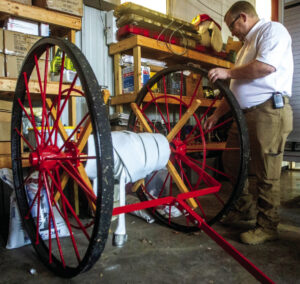Club Chronicles: Practice fire prevention this October
The month of October is recognized as Fire Prevention Month.
Each year the fire prevention awareness campaign focuses on a different aspect of safety, from preventing forest fires to planning an escape route during a blaze. The campaign lasts the entire month, but most police and fire departments designate the second week of October as Fire Prevention Week.
Local entities – such as public libraries, schools, GFWC Book Lovers Study Club, Cultura Garden Club, utility companies, churches and other organizations – join in activities to spread the word not only about fire safety and prevention but overall personal safety.
Sponsored by the National Fire Protection Association, Fire Prevention Month has roots that date back to The Great Chicago Fire of 1871 that killed more than 250 people and left more than 100,000 homeless. The fire, which was reportedly started in a barn, burned more than 2,000 acres and destroyed about 17,400 structures. The three-day fire did most of its damage Oct. 9, 1871, which is why Fire Prevention Week is always held around that date.
The first National Fire Prevention Day was declared by President Woodrow Wilson in 1922, and the week-long observance is the longest-running public safety and health campaign on record.
It’s good to make a yearly evaluation of everything that can be done inside and outside the home to prevent a fire.
Test your fire alarms twice a year. You might consider a direct notification alarm, which automatically alerts the fire department when a fire is detected in the house.
Everyone in the house needs to be educated on how to safely use heat sources such as space heaters, fireplaces, stoves and furnaces, which are a source of ignition for home fires. Never place space heaters against the wall, drapes, piles of clothing or other flammable materials, and keep lids on skillets with hot oil.
Hire a chimney sweep to clean the flue and confirm everything is in good working order before making the first fire in your fireplace each year.
Discuss with your family possible escape routes from different parts of the house. For multi-story homes, make sure you have a folding fire ladder for escape. Teach children basic fire safety tips, such as stop, drop and roll if your clothing catches on fire.
Outdoor fire prevention is also very important. Fires can move from forested areas to residential areas, causing catastrophic damage and taking lives. There are many common hazards in the home landscape that can lead to fires starting in the yard and then spreading to the house or adjacent natural areas.
Large conifers, such as eucalyptus, juniper and pines, are a fire hazard and should not be planted next to the house. In general, species with thick and aromatic sap, papery bark or a tendency to accumulate a lot of dried twigs and leaves should be avoided.
Part of what makes the space around your home defensible is being open and accessible to firefighters so they can easily maneuver their equipment in an area with few flammable objects.
House fires are like car accidents – the tiniest mistakes can cost lives. You only get one chance to do everything right, so put the time aside and make a checklist of everything that can be done to improve fire safety in and around your home.







